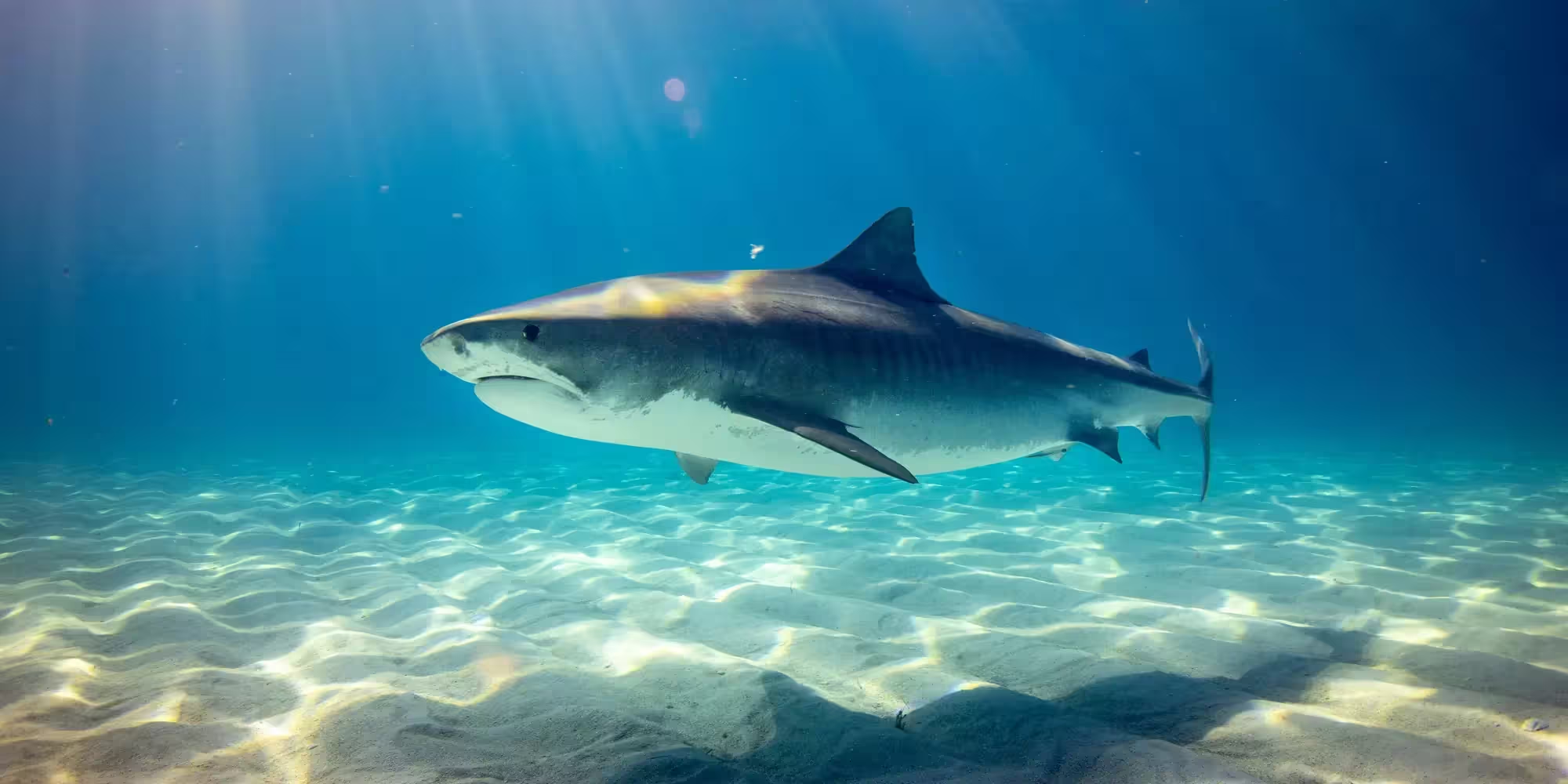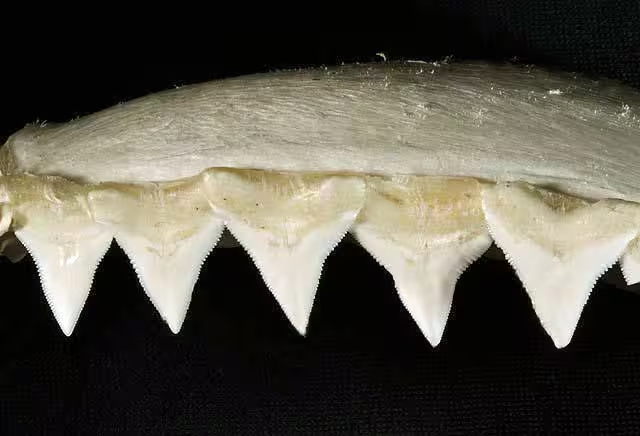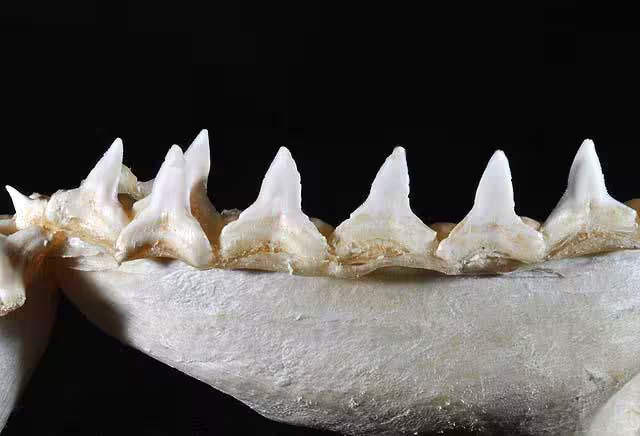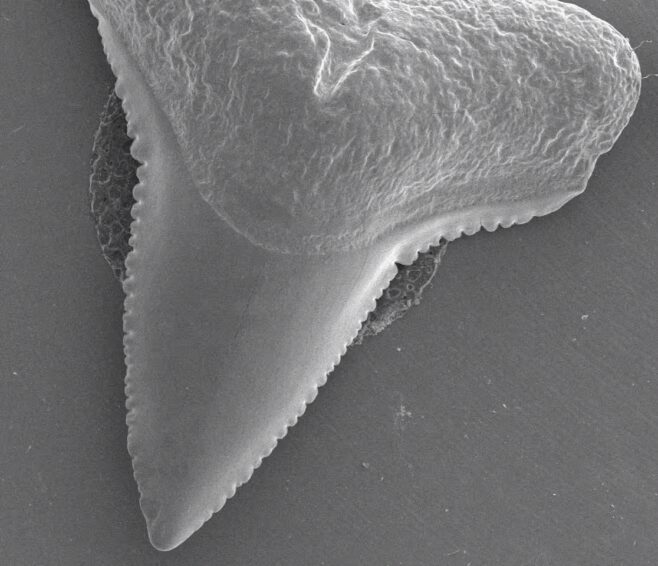The bull shark, scientifically known as Carcharhinus leucas, is one of the most fascinating and at the same time most feared shark species in the world. Its unique ability to survive in both salt and fresh water makes it a special object of scientific research.
Characteristics, Physique & Anatomy
External characteristics of the bull shark
The bull shark is characterised by its robust appearance, which gives it its name. With an average length of 2.1 to 3.5 metres and a weight of up to 230 kilograms, it is a massive sea dweller. Its external features are perfectly adapted to its way of life.
Physique and shape
The bull shark has a stocky, muscular body, which gives it enormous strength and manoeuvrability. Its head is broad and flattened, with a short, blunt snout reminiscent of that of a bull. This head shape makes it easier to manoeuvre in murky waters where visibility is often limited. The eyes are relatively small, indicating that the bull shark relies less on its vision than on other senses.
The skin of the bull shark is covered with placoid scales that have a rough, sandpaper-like texture. These scales reduce water resistance and protect against injuries. The colouring varies depending on the habitat, but is usually grey with a white underside, which is known as “countershading” and helps the shark to camouflage itself from prey and enemies.
Fins and tail
The dorsal fins of the bull shark are distinctive: the first dorsal fin is large and triangular, while the second is significantly smaller. The caudal fin is strong and enables fast, powerful swimming movements. This fin structure supports the shark in sudden changes of direction, making it an efficient hunter.
Anatomy of the bull shark
The anatomy of the bull shark is a prime example of evolutionary adaptation. Its internal and external structures allow it to thrive in a wide variety of environments, from coastal regions to estuaries.
Skeleton and musculature
Like all sharks, the bull shark’s skeleton is made of cartilage, which makes it lighter and more flexible than a bony skeleton. This structure is ideal for the fast, agile movements required for hunting. The musculature is particularly strong, especially along the trunk and the caudal fin, which gives the bull shark its impressive swimming power.
Sensory systems
The bull shark has highly developed senses that help it to detect prey even in murky waters. Its sense of smell is extraordinary: it can detect blood in the water in concentrations of just one part per million. The lateral line, a sensory system along the body, registers vibrations and changes in pressure in the water, while the Lorenzinian ampullae detect electric fields emitted by prey.
Teeth and jaws
Dasestat: The jaw of the bull shark is strong and equipped with sharp, triangular teeth that are arranged in several rows. These teeth are regularly replaced, which enables the shark to crush even hard prey such as turtles or large fish. The bull shark’s bite is one of the strongest among shark species.
Adaptation to different environments
A remarkable feature of the bull shark is its ability to survive in different salinity levels. Its kidneys and glands efficiently regulate the salt balance, which allows it to move between the sea and rivers. This adaptation is also reflected in its robust anatomy, which can withstand the physical demands of such transitions.
Differences between Males & Females
Although male and female bull sharks have a lot in common, there are some physical differences.
Size and weight
Female bull sharks are usually larger and heavier than their male counterparts. While males often reach a length of around 2.1 to 2.8 metres, females can grow up to 3.5 metres long. These differences in size are typical for many shark species and are related to reproductive biology, as larger females can bear more offspring.
Reproductive organs
The most striking difference between males and females is obviously the reproductive organs. Male bull sharks have so-called claspers, modified pelvic fins that are used to transfer sperm. These are externally visible and a clear distinguishing feature. Females, on the other hand, do not have clavers, but a cloaca, which is used for both reproduction and excretion.
Behaviour and physique
While the physique is generally similar, female bull sharks often have a slightly broader body shape, which is related to their role in gestation. Males, on the other hand, can have a slimmer silhouette, which may give them greater manoeuvrability. Behavioural differences, such as territorial behaviour or aggressiveness, are less related to physique than to hormonal factors.
Distribution & Habitat
The bull shark is one of the most versatile and widespread shark species in the world. Its extraordinary ability to survive in both salt and fresh water enables it to colonise a variety of habitats that are inaccessible to other shark species.
Habitat of the bull shark
The bull shark is known for its ability to thrive in a wide variety of aquatic environments. From tropical coastal waters to estuaries and deep river systems, it shows remarkable adaptability.
Coastal waters and oceans
The bull shark’s preferred habitat includes warm, shallow coastal waters that are typically less than 30 metres deep. These regions provide abundant food, such as fish, rays and crustaceans, and are ideal for hunting. Bull sharks are often found in murky waters, such as near coral reefs, lagoons or mangroves, where their robust body structure and keen senses give them an advantage. Tropical and subtropical seas, especially near continental shelves, are their main areas of distribution.
Estuaries and freshwater
A unique feature of the bull shark is its ability to survive in fresh water, which sets it apart from most other shark species. Thanks to a special osmoregulatory system that regulates the salt content in its body, the bull shark can colonise estuaries and even rivers far inland. Well-known river systems in which bull sharks have been sighted include the Amazon in South America, the Mississippi in North America and the Ganges in India. In some cases, bull sharks have been spotted hundreds of kilometres upstream, underlining their extraordinary adaptability.
Adaptation to different environments
The bull shark’s ability to switch between salt and fresh water is due to its physiological adaptations. Its kidneys, liver and rectal gland work together to regulate water and salt balance, allowing it to survive in environments with highly fluctuating salinity levels. This flexibility makes the bull shark an opportunistic hunter that is successful in diverse ecosystems.
Global distribution of the bull shark
The bull shark is a cosmopolitan species that occurs in many parts of the world. Its distribution extends across tropical and subtropical regions, and it can be found in all major oceans.

Atlantic Ocean
The bull shark is widespread in the Atlantic Ocean, especially along the coasts of North and South America. On the east coast of the United States, it can be found from Massachusetts to the Gulf of Mexico, although it is particularly common in the warm waters of Florida. In the Caribbean, it is a permanent inhabitant of coastal waters and estuaries. On the South American coast, its range extends from Venezuela to Argentina, with regular sightings in the Amazon Delta.
Pacific Ocean
In the Pacific Ocean, the bull shark is found along the coasts of Central and South America as well as in parts of Asia and Australia. In Central America, it is often found in the waters of Panama and Costa Rica, while in South America it is mainly found in the coastal areas of Peru and Ecuador. In Australia, the bull shark is found in the tropical waters of Queensland and the Northern Territory, often in rivers such as the Fitzroy River.
Indian Ocean
In the Indian Ocean, the bull shark’s distribution stretches from the east coast of Africa to south-east Asia. In South Africa, it is common in the warm waters of the province of KwaZulu-Natal, especially near Durban. In India and Bangladesh, the bull shark has been sighted in large river systems such as the Ganges and Brahmaputra, which emphasises its ability to penetrate far inland.
Island regions and remote areas
Bull sharks are also found in remote island regions such as the Maldives, the Seychelles and the islands of the Pacific, including Fiji and Hawaii. This distribution shows that the bull shark is capable of travelling long oceanic distances to find new habitats.
Factors influencing the distribution
The distribution of the bull shark is influenced by several factors, including water temperature, food availability and reproductive needs. Bull sharks prefer water temperatures between 20 and 28 degrees Celsius, which explains why they are mainly found in tropical and subtropical regions. Estuaries and coastal waters offer plenty of food and shelter, making them favourite places for breeding and rearing their young.
Reproduction
Reproductive strategy of the bull shark
The bull shark is a viviparous shark, which means that the young are born alive. This reproductive strategy, known as viviparous placentation, distinguishes it from oviparous species that lay eggs. The reproduction of the bull shark is closely linked to its habitats, as the choice of birth sites plays a decisive role in the survival of the young.
Viviparity and placentation
In viviparous reproduction, the embryos develop in the womb, where they are nourished by a placenta-like structure known as the yolk sac-placenta. This structure supplies the young with nutrients and oxygen, similar to mammals. The gestation period of the bull shark is around 10 to 11 months, whereby the females usually give birth every two years, as they need a resting phase after giving birth.
Mating behaviour
The mating behaviour of the bull shark is often aggressive. Male bull sharks often bite the females during mating in order to fixate them, which can lead to visible bite marks on the females’ skin. This behaviour is typical of many shark species. Mating usually takes place in coastal waters or estuaries, where both sexes come together. Males use their claspers, modified pelvic fins, to transfer sperm.
Reproductive cycle
The reproductive cycle of the bull shark is highly dependent on environmental factors such as water temperature and food availability. In tropical regions, reproduction can take place all year round, whereas in subtropical regions it is often seasonal.
Gestation period and litter size
After fertilisation, female bull sharks carry their young for about 10 to 11 months. A litter typically consists of 1 to 13 young, with 6 to 8 being the most common number. At birth, the young are around 60 to 80 centimetres long and fully developed so that they can immediately swim and hunt independently.
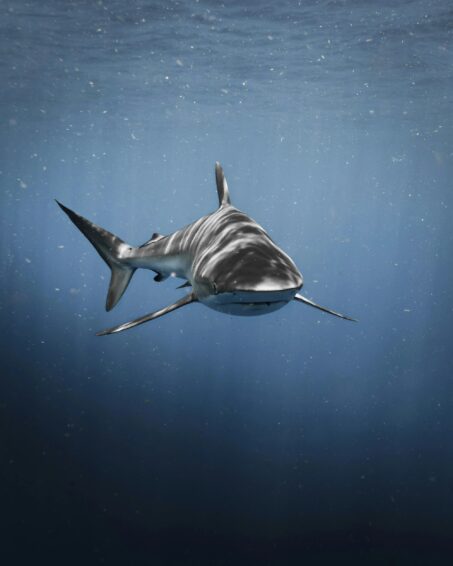
Rearing the young
After birth, the young often seek out shallow, sheltered waters such as estuaries or lagoons, which serve as so-called “nurseries”. These areas offer protection from predators and plenty of food, which promotes the survival of the young. Unlike some other shark species, the mothers do not care for their offspring after birth, as the young are independent from the start.
Known birthplaces
The choice of birthing sites is a decisive factor for the reproductive success of the bull shark. Due to its ability to survive in fresh and salt water, it utilises a variety of ecosystems as birthing grounds.
Estuaries and lagoons
Estuaries are particularly favoured birthing grounds for bull sharks as they offer protection and food. In North America, the Gulf of Mexico, especially the coastal waters of Florida, is a well-known birthplace. The lagoons and estuaries along the Atlantic coast, such as the Indian River in Florida, serve as important nurseries. In South America, the estuaries of the Amazon and the Orinoco River are important birthplaces.
Tropical coastal waters
In tropical regions, bull sharks use shallow coastal waters and mangroves as birthing grounds. In the Caribbean, the waters around Cuba, the Bahamas and Jamaica are known for their high populations of juveniles. In Australia, the coastal areas of Queensland, especially the waters around the Great Barrier Reef region, serve as important breeding grounds.
Freshwater systems
A remarkable feature of the bull shark is its use of freshwater systems for reproduction. In Central America, the waters of Lake Nicaragua, which is connected to the Caribbean Sea via the San Juan River, are a well-known birthplace. In Asia, bull sharks have been sighted in the Ganges and Brahmaputra river systems, where they give birth to their young. This ability to utilise freshwater habitats makes the bull shark unique among shark species.
Factors influencing reproduction
The reproduction of the bull shark is influenced by several factors, including environmental conditions and human activities. Warm water temperatures between 20 and 28 degrees Celsius promote reproduction as they provide optimal conditions for embryo development. The availability of food at the birth sites is also crucial, as young animals are dependent on food immediately after birth.
Human interference such as overfishing, pollution and the destruction of coastal habitats can jeopardise the reproduction of the bull shark. Pollution of estuaries and mangroves in particular can affect nurseries, which could impact populations in the long term.
Hunting, Nutrition & Predators
Diet of the bull shark
The bull shark is an opportunistic carnivore with a wide range of prey. Its diet reflects its adaptability to different habitats, from tropical coastal waters to river systems.
Prey
The bull shark’s diet includes a variety of marine animals, including fish, rays, crustaceans, sea turtles and even other sharks. Common prey includes bony fish such as perch and mackerel, as well as smaller sharks such as blacktip sharks. In estuaries and freshwater habitats, the bull shark also hunts freshwater fish, crustaceans and occasionally birds or small mammals that get into the water. This diversity makes it an extremely successful hunter in a wide variety of ecosystems.
Food intake and digestion
The bull shark has a powerful set of sharp, triangular teeth that are arranged in several rows and are regularly renewed. These teeth are ideal for gripping and crushing prey, even hard shells like those of turtles. Its digestive system is robust and enables it to process large quantities of food. The bull shark can also go for long periods without food, which helps it to survive in environments with fluctuating food availability.
Hunting behaviour of the bull shark
The hunting behaviour of the bull shark is characterised by aggressiveness, precision and a remarkable adaptation to its environment. Its senses and physique make it an efficient hunter that is successful in both clear and murky waters.
Hunting techniques
The bull shark uses different hunting strategies depending on its habitat. In murky waters, such as estuaries or coastal areas, it relies heavily on its sense of smell, which can detect blood in the water in concentrations of just one part per million. Its lateral line registers vibrations, while the Lorenzinian ampullae recognise electrical signals from prey. These senses enable it to detect prey even in almost zero visibility.
A common hunting technique of the bull shark is the “bump-and-bite” approach: it first bumps into the prey with its snout to disorientate it before snapping. This method is particularly effective with larger or defensive prey. In open waters, it uses its speed and powerful tail fin to overpower prey in quick, targeted attacks.
Adaptation to the habitat
In coastal waters, the bull shark often hunts in groups or alone, depending on the availability of prey. In river systems where visibility is limited, it relies more on its senses and moves slowly to conserve energy. Its ability to switch between salt and fresh water considerably extends its hunting range, as it can pursue prey in rivers, lagoons and open seas.
Predators of the bull shark
As an apex predator, the adult bull shark has few natural enemies. Nevertheless, there are some threats, especially for juveniles and in certain situations.
Natural predators
Young bull sharks are more susceptible to predation than adults. Larger sharks, such as the tiger shark or the great white shark, can attack juveniles or smaller bull sharks, especially in open waters. In river systems, crocodiles or alligators, for example in the Amazon or in Australian rivers, can pose a threat to young bull sharks. These predators use the shallow waters in which bull sharks are often born as hunting grounds.
Human threats
Humans are the biggest threat to the bull shark, although they are not considered a direct predator. Overfishing, bycatch in fishing nets and the destruction of habitats such as mangroves and estuaries jeopardise the populations. In some regions, bull sharks are deliberately hunted, either for their fins, their meat or as a perceived threat to bathers. Their proximity to human settlements, especially in coastal areas, often leads to conflicts.
Competition for food
In some habitats, bull sharks compete with other apex predators for food. In tropical seas, tiger sharks or hammerheads may compete for the same prey, which can lead to aggressive interactions. However, this competition is less of a threat than a natural part of the ecosystem.
Ecological role
The bull shark plays a crucial role in the marine and fluvial ecosystem. As an apex predator, it regulates the populations of prey and thus contributes to maintaining the ecological balance. Its ability to hunt in different habitats makes it an important factor in the biodiversity of coastal and river ecosystems. By eliminating weak or sick animals, it strengthens the health of prey populations.
Bull Sharks & Humans
Interaction with humans
The bull shark’s proximity to coastal areas and river systems regularly leads to encounters with humans. These interactions range from fascinating observations to conflicts that often arise from misunderstandings about the shark’s behaviour.
Encounters in coastal waters
Bull sharks are frequently encountered in shallow coastal waters that are also used by humans for recreational activities such as swimming, surfing or fishing. In regions such as Florida, South Africa or Queensland, such encounters are not uncommon. The bull shark is curious and may approach humans to examine them, which is sometimes perceived as a threat. Its preference for murky waters increases the likelihood of unexpected encounters, as neither humans nor sharks have clear visibility.
Attacks on humans
Although rare, bull sharks are one of the shark species blamed for attacks on humans. Their strong stature and powerful bite make such incidents potentially dangerous. However, many of these attacks are not targeted, but result from mistaken identity, where the shark mistakes a human for prey, for example due to unclear silhouettes in the water. Statistically, shark attacks are extremely rare and most encounters with bull sharks are without incident.
Human activities and impacts
Human activities have a significant impact on the coexistence with bull sharks. Overfishing reduces the shark’s food base, which can force it to hunt closer to coastlines or human settlements. Pollution of estuaries and coastal waters affects bull shark habitats, while tourism, especially shark diving, increases interactions with humans. In some regions, bull sharks are deliberately hunted or killed as a threat, jeopardising their populations.
Measures for peaceful coexistence
A better understanding of the bull shark can reduce conflicts and promote harmonious coexistence. There are several approaches to make interactions safer and more sustainable.

Education and prevention
Education campaigns are crucial to inform people about the behaviour of bull sharks. Swimmers and surfers should avoid murky waters, especially at dusk or after heavy rainfall when bull sharks are more active. Warning signs on beaches and monitoring of coastal waters can minimise the risk of encounters.
Habitat protection
The protection of bull shark habitats, such as mangroves, estuaries and coastal waters, is essential to maintain populations and reduce conflicts. Clean waters and intact ecosystems reduce the need for bull sharks to enter human areas. Protected areas where fishing is restricted promote food availability and stabilise populations.
Responsible tourism
Shark tourism, such as cage diving, provides an opportunity to safely observe bull sharks while generating revenue for conservation. Responsible operators take care not to stress the animals by feeding or harassing them, which contributes to more positive interactions in the long term.
Freshwater Species
Bull sharks have been sighted in numerous freshwater systems worldwide, often hundreds of kilometers from the coast. A well-known example is Lake Nicaragua in Central America, which is connected to the Caribbean Sea via the San Juan River. In this lake, bull sharks live permanently in freshwater, which distinguishes them from their marine counterparts. Similar populations have been documented in the Amazon in South America, the Ganges in India, and the Zambezi in Africa. These populations often spend their entire lives in freshwater but occasionally return to the sea, particularly for reproduction.
The freshwater populations show no significant morphological differences from their marine counterparts, suggesting that they are the same species adapting to different environments. Their diet in freshwater includes freshwater fish, crustaceans, and occasionally small mammals, highlighting their opportunistic nature.
Subspecies of the Bull Shark: Scientific Perspective
The question of whether subspecies of the bull shark exist is controversial in the scientific community. Currently, Carcharhinus leucas is classified as a single species with no recognized subspecies, although its wide distribution and adaptability have sparked speculation about possible genetic differentiations.
Genetic Studies and Classification
Genetic analyses have shown that bull sharks worldwide exhibit high genetic diversity, which is attributed to their wide distribution and mobility. Despite this diversity, there is no clear evidence for the existence of subspecies. The freshwater populations, such as the one in Lake Nicaragua, were originally considered potential subspecies, particularly due to their permanent presence in freshwater. Earlier designations such as Carcharhinus nicaraguensis for the Lake Nicaragua population were later rejected, as genetic studies confirmed that they are Carcharhinus leucas.
The genetic similarity between marine and freshwater populations suggests that bull sharks possess a high degree of plasticity, enabling them to adapt to different environments without speciation occurring. Nevertheless, further studies are underway to investigate possible regional differences, especially in isolated freshwater populations.
Morphological and Behavioral Differences
Morphologically, freshwater bull sharks show no significant differences from their marine counterparts. Their body structure, including their muscular build, short snout, and strong fins, remains consistent. Behavioral differences, such as a stronger preference for freshwater habitats or adapted hunting strategies, are more likely the result of ecological adaptations rather than genetic divergence. For example, freshwater populations often hunt in slower-moving waters and use their senses to detect prey in murky rivers.
The absence of recognized subspecies could also be due to the mobility of the bull shark, as it regularly moves between salt and freshwater, maintaining gene flow between populations. This mobility prevents the isolation necessary for the formation of subspecies.
Challenges and Threats to Freshwater Populations
Freshwater populations of the bull shark face unique challenges that threaten their existence. Human activities such as dam construction, pollution, and overfishing impair river systems and limit access to freshwater habitats. In Lake Nicaragua, for example, pollution from agricultural runoff has deteriorated water quality, affecting food availability for bull sharks. Similar problems occur in other river systems such as the Ganges, where industrial pollution degrades habitats.
Furthermore, freshwater populations can become isolated if access to the sea is blocked by human intervention, which could reduce their genetic diversity in the long term. Protecting these habitats is essential to ensure the survival of the freshwater forms of the bull shark.

